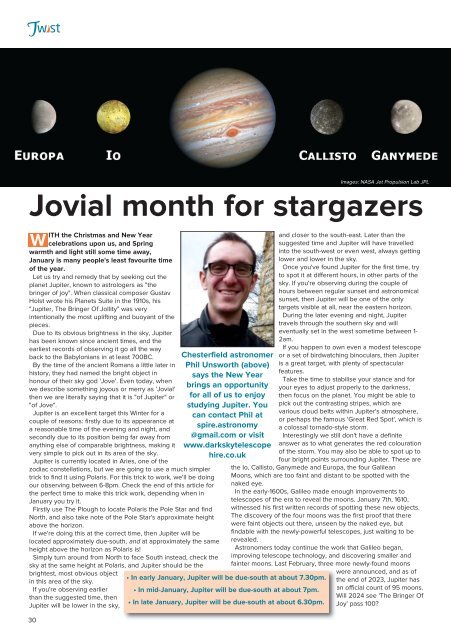Twist Issue 157 January 2024
You also want an ePaper? Increase the reach of your titles
YUMPU automatically turns print PDFs into web optimized ePapers that Google loves.
Tw st<br />
30<br />
ITH the Christmas and New Year<br />
celebrations upon us, and Spring<br />
warmth and light still some time away,<br />
<strong>January</strong> is many people's least favourite time<br />
of the year.<br />
Let us try and remedy that by seeking out the<br />
planet Jupiter, known to astrologers as "the<br />
bringer of joy". When classical composer Gustav<br />
Holst wrote his Planets Suite in the 1910s, his<br />
"Jupiter, The Bringer Of Jollity" was very<br />
intentionally the most uplifting and buoyant of the<br />
pieces.<br />
Due to its obvious brightness in the sky, Jupiter<br />
has been known since ancient times, and the<br />
earliest records of observing it go all the way<br />
back to the Babylonians in at least 700BC.<br />
By the time of the ancient Romans a little later in<br />
history, they had named the bright object in<br />
honour of their sky god 'Jove'. Even today, when<br />
we describe something joyous or merry as 'Jovial'<br />
then we are literally saying that it is "of Jupiter" or<br />
"of Jove".<br />
Jupiter is an excellent target this Winter for a<br />
couple of reasons: firstly due to its appearance at<br />
a reasonable time of the evening and night, and<br />
secondly due to its position being far away from<br />
anything else of comparable brightness, making it<br />
very simple to pick out in its area of the sky.<br />
Jupiter is currently located in Aries, one of the<br />
zodiac constellations, but we are going to use a much simpler<br />
trick to find it using Polaris. For this trick to work, we'll be doing<br />
our observing between 6-8pm. Check the end of this article for<br />
the perfect time to make this trick work, depending when in<br />
<strong>January</strong> you try it.<br />
Firstly use The Plough to locate Polaris the Pole Star and find<br />
North, and also take note of the Pole Star's approximate height<br />
above the horizon.<br />
If we're doing this at the correct time, then Jupiter will be<br />
located approximately due-south, and at approximately the same<br />
height above the horizon as Polaris is!<br />
Simply turn around from North to face South instead, check the<br />
sky at the same height at Polaris, and Jupiter should be the<br />
brightest, most obvious object<br />
in this area of the sky.<br />
If you're observing earlier<br />
than the suggested time, then<br />
Jupiter will be lower in the sky,<br />
Chesterfield astronomer<br />
Phil Unsworth (above)<br />
says the New Year<br />
brings an opportunity<br />
for all of us to enjoy<br />
studying Jupiter. You<br />
can contact Phil at<br />
spire.astronomy<br />
@gmail.com or visit<br />
www.darkskytelescope<br />
hire.co.uk<br />
Images: NASA Jet Propulsion Lab JPL<br />
Jovial month for stargazers<br />
W<br />
and closer to the south-east. Later than the<br />
suggested time and Jupiter will have travelled<br />
into the south-west or even west, always getting<br />
lower and lower in the sky.<br />
Once you've found Jupiter for the first time, try<br />
to spot it at different hours, in other parts of the<br />
sky. If you're observing during the couple of<br />
hours between regular sunset and astronomical<br />
sunset, then Jupiter will be one of the only<br />
targets visible at all, near the eastern horizon.<br />
During the later evening and night, Jupiter<br />
travels through the southern sky and will<br />
eventually set in the west sometime between 1-<br />
2am.<br />
If you happen to own even a modest telescope<br />
or a set of birdwatching binoculars, then Jupiter<br />
is a great target, with plenty of spectacular<br />
features.<br />
Take the time to stabilise your stance and for<br />
your eyes to adjust properly to the darkness,<br />
then focus on the planet. You might be able to<br />
pick out the contrasting stripes, which are<br />
various cloud belts within Jupiter's atmosphere,<br />
or perhaps the famous 'Great Red Spot', which is<br />
a colossal tornado-style storm.<br />
Interestingly we still don't have a definite<br />
answer as to what generates the red colouration<br />
of the storm. You may also be able to spot up to<br />
four bright points surrounding Jupiter. These are<br />
the Io, Callisto, Ganymede and Europa, the four Galilean<br />
Moons, which are too faint and distant to be spotted with the<br />
naked eye.<br />
In the early-1600s, Galileo made enough improvements to<br />
telescopes of the era to reveal the moons. <strong>January</strong> 7th, 1610,<br />
witnessed his first written records of spotting these new objects.<br />
The discovery of the four moons was the first proof that there<br />
were faint objects out there, unseen by the naked eye, but<br />
findable with the newly-powerful telescopes, just waiting to be<br />
revealed.<br />
Astronomers today continue the work that Galileo began,<br />
improving telescope technology, and discovering smaller and<br />
fainter moons. Last February, three more newly-found moons<br />
• In early <strong>January</strong>, Jupiter will be due-south at about 7.30pm.<br />
• In mid-<strong>January</strong>, Jupiter will be due-south at about 7pm.<br />
• In late <strong>January</strong>, Jupiter will be due-south at about 6.30pm.<br />
were announced, and as of<br />
the end of 2023, Jupiter has<br />
an official count of 95 moons.<br />
Will <strong>2024</strong> see 'The Bringer Of<br />
Joy' pass 100?


















